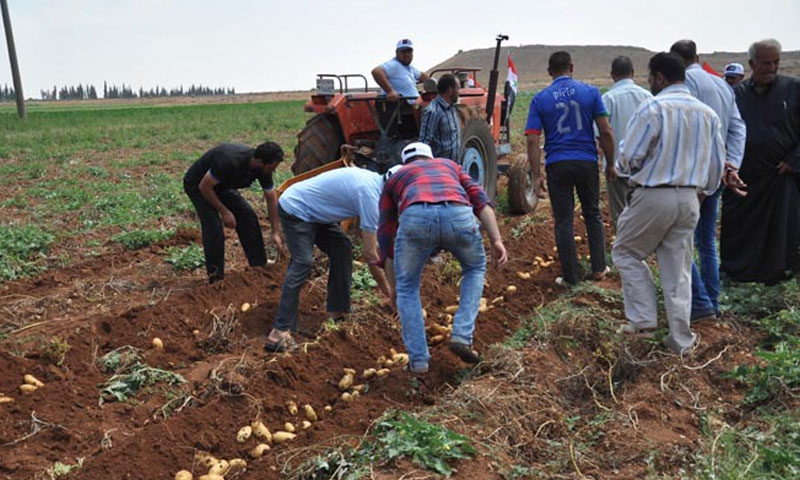Homs – Despite this year’s abundance with potato crop in rural Homs, the farmers’ revenues are almost nonexistent, for the production costs are twice the last year’s and the commodity’s price in the market is fixed, unchanged in the face of the dollar appreciation exchange rate to the Syrian pound.
The potato’s diminishing revenues this season have forced the farmers to storing their crops in refrigeration units as to avoid losses, given that its price on the Syrian market is related to offer and demand, while the production supplies, including seeds and fertilizers, are linked to dollar exchange rates, placing the farmers before an impossible to solve equation.
Soaring Costs and Low Prices
Potato is a crop that farmers in rural Homs fundamentally rely on, despite the high costs of production because it is the most profitable – compared to other crops.
The deprecation of the Syrian pound exchange rates has massively increased the costs of potato production, for the supplies needed for its cultivation are imported, the seed, for instance, are imported from the Netherlands, and the majority of the fertilizers and pesticides are foreign, the prices of which rise with every boost in the dollar exchange rates.
The price of a single seed bag has increased to about 45 thousand SP (90$) when he bought it three months ago while it was sold for about 23 thousand SP in 2019, half of the price, says Mohammad Abu Ismail, a farmer from the town of Kafr Laha, al-Houla Plain.
The General Organization for Seed Multiplication (GOSM) blamed the price increase on the country of manufacture and the sanctions imposed on Syria. However, Abu Ismail attributed the matter “to the greed of the importers.”
The increase in seed prices corresponded to a rise in the prices of fertilizers and pesticides – turning into twice their previous price.
The market price of potato, nevertheless, stuck to the last year’s, as it varies between 125 and 150 SP per kilogram based on the harvest’s quality, the farmer explains to Enab Baladi.
“To sell the crop for 2018’s price, potato must be offered for 200SP at least. And this is so we can continue cultivation […]. It is illogical that the production costs become two times the last year’s while the kilo’s price remains fixed, unchanging,” he adds.
A member of the Farmers Association in the city of Talbiseh, on the condition of anonymity, told Enab Baladi that the Association failed to find a solution for this problem, increasing seed prices, pointing out that the economic reality has coerced the farmers into dealing with dollar due to the instability of the exchange rates.
He did not make any profits this year despite the abundance of the harvest.
Between Offer and Demand
Potato is a basic ingredient of the Syrian house’s pantry and its price is determined by offer and demand in the vegetable markets in all the Syrian governorates.
Abu Saer, a merchant at the al-Hal Market in Homs city, says that the commodity’s price is linked to offer and demand in the vegetable markets throughout the different governorates, and “it is absurd to relate its price to the dollar because it is not the principal currency in the country. But the production needs’ relation to import has placed the farmers at the mercy of the exchange rates.”
After selling his crops, the merchant added, the farmer will end up with zero revenues, especially upon converting the value of the crops to the dollar, believing that “the dollar is what has consumed the farmer’s profits, and the government of the regime could not care less. Even if it cared, it is incapable of doing anything, and its goal is declining the price of potato regardless of the farmers’ loss.”
Storage and Refrigeration Adventure
Some of the farmers risk storing their crops in refrigeration units, hoping to make whatever gains after the hectic work during the season and cautious of the next year’s production costs. But still, the exchange rate continues to be their greatest obsession upon choosing the refrigeration adventure.
Khalid Abu Mousa, a farmer from the al-Rastan city, told Enab Baladi that he has contracted with one of the refrigeration units’ owners, where he is to store the crops in an attempt at avoiding losses.
He added that the current prices of potato are leading him to an ultimate loss, but he resorted to refrigerating his harvest in a step to avoid the loss despite the high costs of refrigeration considering that there are only a few refrigeration units in the area.
The monthly cost of refrigeration is 15 thousand SP per kilogram, commenting on which the farmer added that “the exchange rate is the greatest danger to revenues. However, the matter is worth the adventure.”

